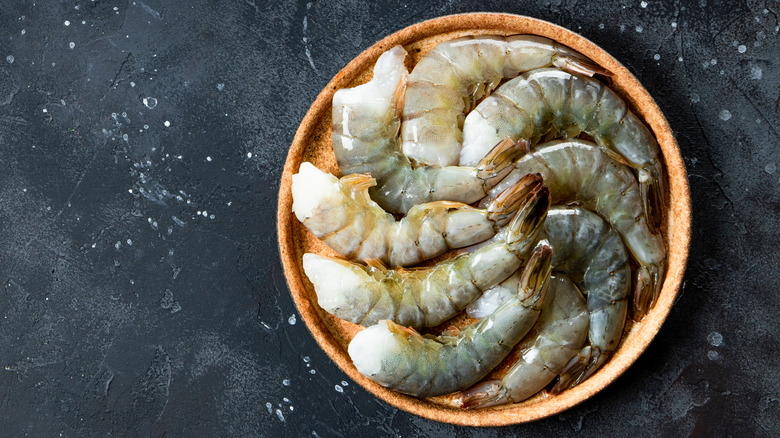Why Does Shrimp Change Color When Cooked?
Everyone who loves seafood knows that shrimp are some of the best delicacies the world's lakes and oceans have to offer. Ranging in size from teeny-tiny to large and meaty, these sweet, firm-fleshed crustaceans are a delight in so many classic dishes — from New Orleans-syle po'boys to garlicky shrimp scampi to creamy shrimp bisque. It's no wonder that shrimp is the United States' top-selling seafood item, with the average American consuming about 4.6 pounds per year, according to IntraFish.
In addition to tasting absolutely delicious, shrimp happen to be very beautiful. Live shrimp can be brilliantly colored and feature a range of patterns, as AquaViews reports, from the red-and-white-striped banded boxer shrimp and the bright blue Pederson shrimp to the translucent clown anemone shrimp and the white-speckled sexy shrimp (yes, it's a real thing). If you've ever picked up fresh, shell-on shrimp from the seafood market, you've likely noticed the variegated hues in their shells. And you've just as likely noticed that no matter what the shrimp looks like when it's raw, it turns a bright, pinky-orange hue as soon as it's cooked. What accounts for this miraculous transformation? Read on to find out.
It's all explained by science
Ready to nerd out a bit? Because to understand why blue-gray shrimp turn bright pink when cooked, we're going to have to turn to science. As explained by HuffPost, the surface we call a "shell" on a shrimp is more technically known as its exoskeleton, a hard covering that protects the bodies of some animals and insects, typically invertebrates, who lack the support of a backbone (via Britannica Kids). In shrimp, this exoskeleton contains pigments called astaxanthin, the same pigments that lend fresh salmon its pink color. But in uncooked shrimp, the astaxanthin are wrapped up in protein chains called crustacyanin, which covers up the astaxanthin's pinkish hue.
HuffPost explains that when shrimp are dropped into hot water or tossed into a sauté pan, heat loosens the crustacyanin, revealing the astaxanthin and its lovely color. This is the same reaction that occurs when brownish raw lobsters are cooked and turn bright red. Want to glean one more fun science fact before you go? Flamingos are pink because they consume high volumes of shrimp. Although they don't have the means to cook the shrimp they eat, their digestion process loosens the crustacyanin chains, releasing the pink astaxanthin displayed in the birds' feathers.

